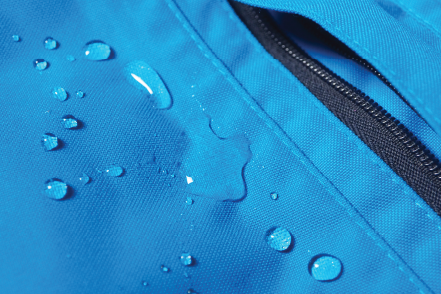Unfortunately, No nylon isn’t waterproof and absorbs water as it lets the moisture pass through. As a result, it will take time to dry when soaked.
This material is made of plastic, which is chemically derived from crude oil. It’s then chemically treated to produce stretchy fabrics that can be used in various types of bags.
Nylon is also used in various other industries and applications, including fishnets, ropes, parachutes, seat belts, and tents.
Bag manufacturers use nylon to make bags that can be used in wet weather. So, a backpack made of nylon will withstand a light rain shower, but it will soak after a while.
Some higher denier nylon fabrics won’t let water pass through, but they are still not considered waterproof. As a result, water leakage depends on how thick the material is.
Different types of nylon materials have various values of hydrostatic head or HH. This is an indication in millimeters that determines how high a water column should be before the water penetrates the fabric.
Here are some examples of Nylon thickness:
- 7D nylon is lightweight and breathable, so it’s mainly used to make clothing apparel. It’s less durable and has an HH value between 1000 and 2000 mm.
- 20D nylon is lightweight and more durable, so it’s used to make ultralight inflatables like air pillows. It has an HH value between 3000 and 4000 mm.
- 40D nylon is resilient with decent durability. This is why it’s widely used in outdoor applications, where it can be used to make tarps and tents. It has an HH value of 5000 mm.
- 400D nylon is one of the most durable options, so it’s used in military and tactical gear. Cutting these fabric is tough and It’s resistant to cuts, handles abuse better than the other types, and has an HH value of 20,000 mm.
Is Nylon Water-Resistant?
Most nylon fabrics are considered water-resistant to some extent, and manufacturers follow different practices to enhance their water-resistant properties.
For example, the manufacturing process can be adjusted by making the fabric weave extra tight. The water won’t pass through, so the material will be more water-resistant.
Some manufacturers mix nylon with other fabrics to enhance its water resistance. Coatings like rubber and urethane can be applied to nylon to make it more resistant to moisture. These coatings make water slide on top of the fabric, and the particles don’t pass through the nylon fibers.
Manufacturers apply these coatings during the manufacturing process. But alternatively you can buy waterproofing sprays for nylon over the counter.
For example, if you’re using nylon bags and Clothing outdoors, you can spray these items with a coating that will instantly create a barrier over the fabric weave and cause the water to bead and slide off nylon’s surface.
Are Some Types of Nylon More Water-Resistant Than Others?
A Nylon variation known as Ripstop Nylon is notably water-resistant and comes in light, medium, and heavyweight varieties. It has interwoven ripstop reinforcement threads, making it more durable and water-resistant. It’s resilient and ideally suited for bags that will face heavy wear and tear.
As the name suggests, this fabric is commonly used in outdoor apparel and accessories like tents and backpacks. It doesn’t rip, and even if it accidentally rips, the tear will stop quickly, so your nylon bag will still be usable.
Lightweight Ripstop Nylon is usually used to make apparel and tents. This type of fabric is more breathable.
Medium-weight Ripstop Nylon is used to make sleeping bags and backpacks. It can be warmer, but still slightly breathable.
Heavyweight Ripstop Nylon is used to manufacture sails and other heavy industrial applications.
Some types of nylon ripstop can be fire-resistant, too. After it’s made, this material is covered with a resin coating to make it fire-resistant and waterproof at the same time.

The Difference Between Waterproof and Water-Resistant Fabric?
Some people mistakenly use the two terms interchangeably, they sound the similar but they are in fact different levels of water the water resistance concept.
Waterproof material: Keeps all the water out of the fabric and doesn’t allow it to pass through. So, when the material gets wet, the water pools on its surface and slides away. Such a material won’t be breathable but will be resilient and durable.
Water-resistant material: Will allow some of the moisture to pass through. The resistance degree depends on the fabric type and the coating applied on top. Water-resistant materials are more breathable.
What Happens When Nylon Gets Wet?
Nylon is actually hygroscopic, absorbing moisture from the air or when submerged in water. Water will change nylon’s properties and make it less stiff.
After a while, this material becomes saturated, so it can’t absorb more moisture. At this point, nylon will take a long time to dry.
However, it’s best to let this material dry indoors or away from the sun because nylon can be damaged with sun exposure.
Wrapping Up
Nylon isn’t inherently waterproof, but some types are when integrated with other materials. Some manufacturers use waterproof coatings to prevent water from passing through nylon fabrics and prevent moisture from passing through the fabric.
Most types of nylon are naturally water-resistant to some extent. So, they will let some but not all of the moisture to pass through. Some nylon materials are mixed with other fibers to enhance their water-resistance properties.
Nylon ripstop is considered more water-resistant because it’s made differently. Heavyweight types of nylon ripstop are mainly used for outdoor and industrial applications because these materials are more resilient.
